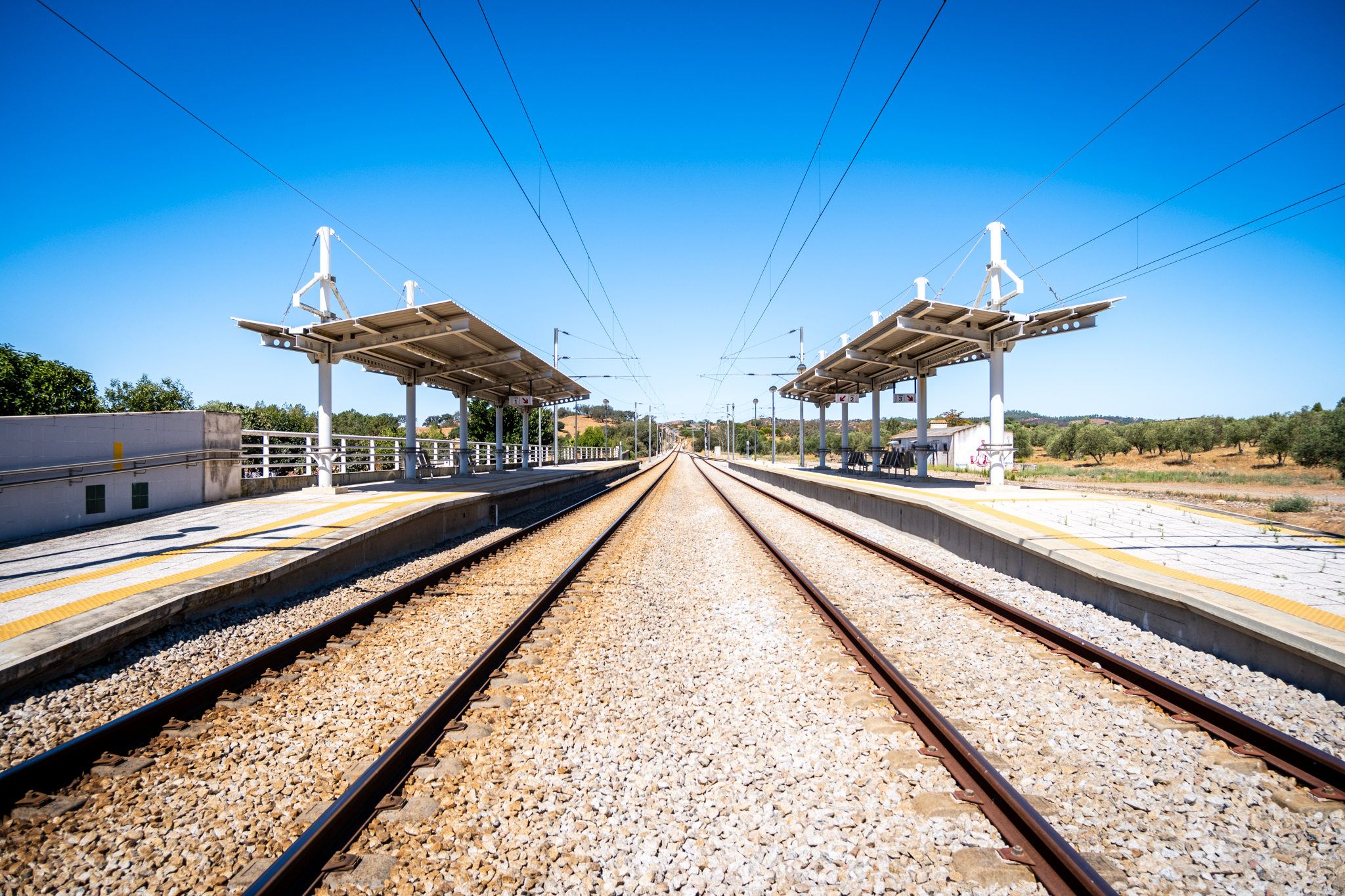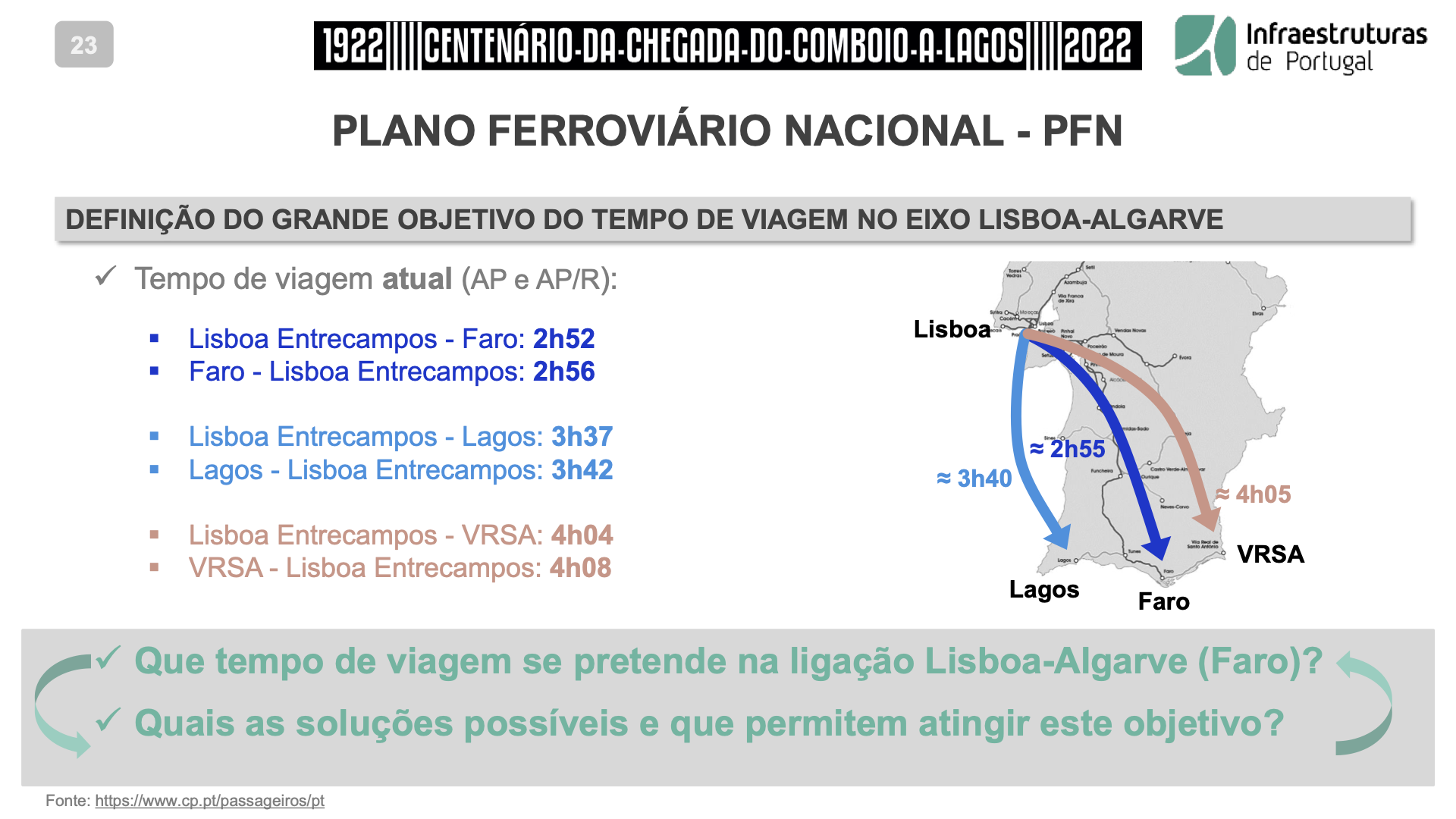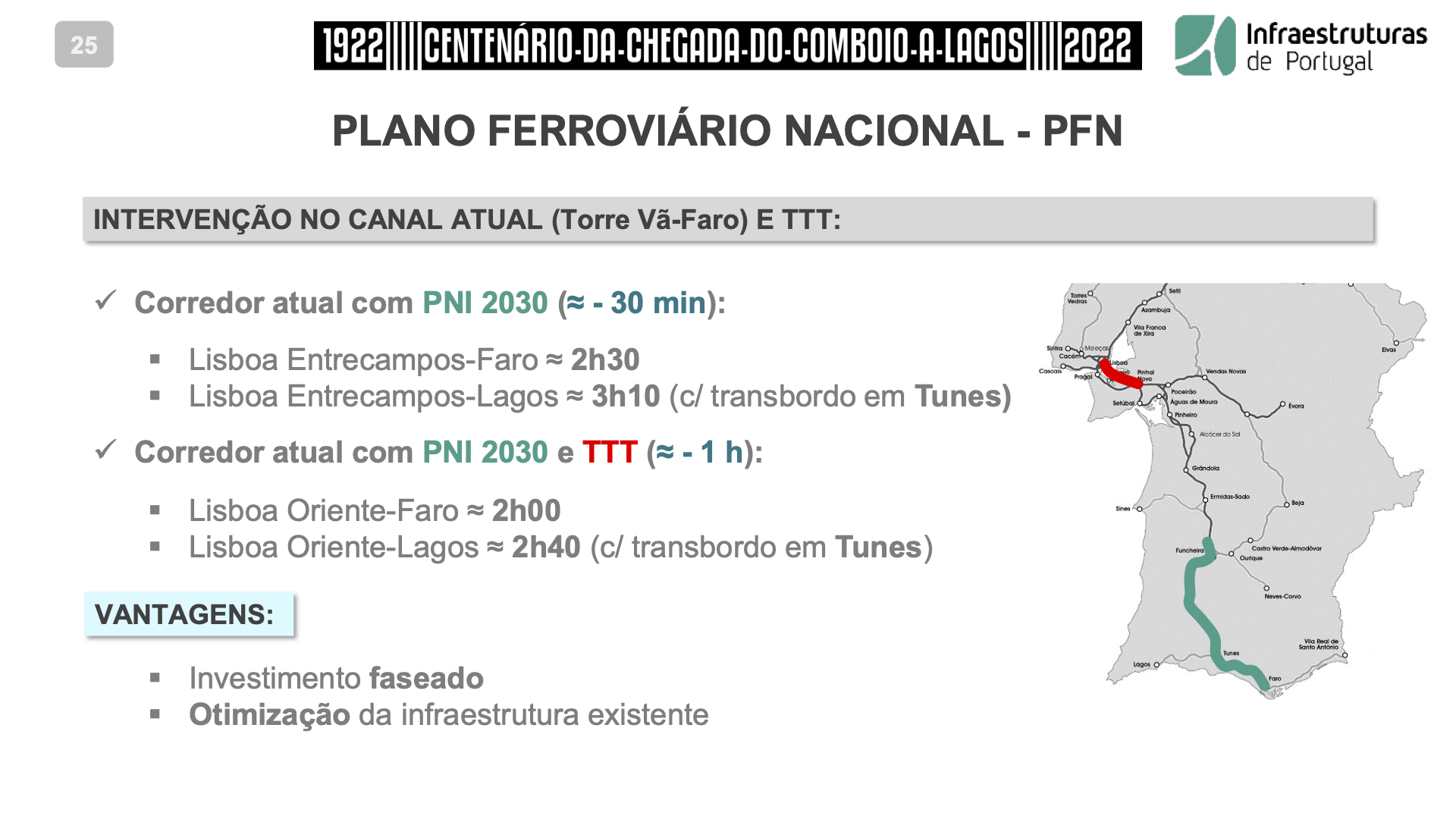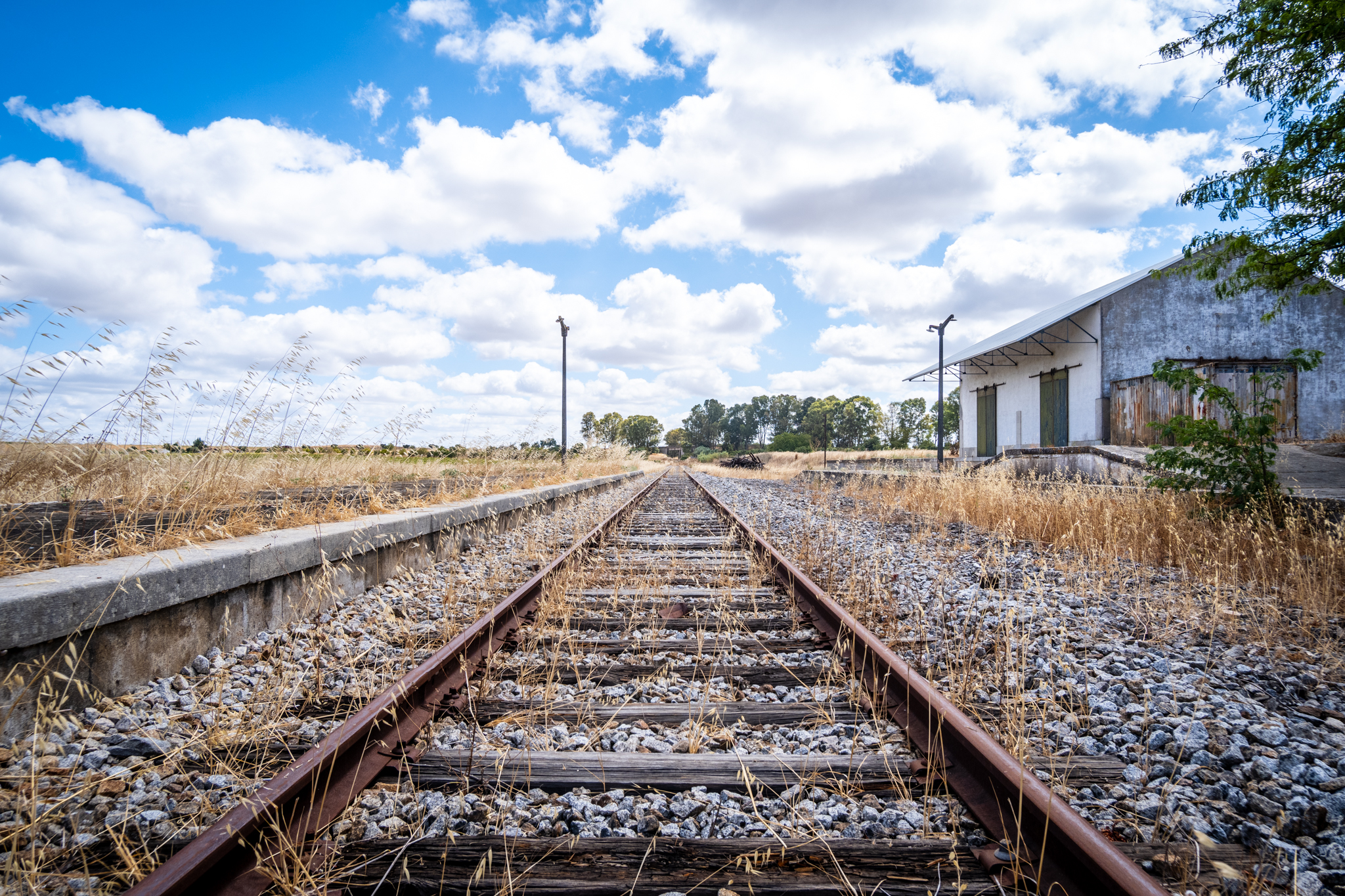An improvement to the current South Line with the new bridge over the Tagus would allow Lisbon to be located 2 hours away from Faro. A new high speed line between Lisbon and Faro would make the two cities 1h40 away, connecting Evora and Beja to the Algarve at the same time.

In a presentation held to commemorate the 100th anniversary of the arrival of the Lagos train, the Infraestruturas de Portugal (IP), responsible for managing the national rail network, discussed two alternatives that are being considered to reduce travel time between Lisbon and the Algarve: One of them is to improve the current Southern Line, allowing between 30 minutes and 1 hour off the current trip, and the other is to build a new high-speed line, which would save 1h20.
The two options are being considered in the scope of the National Railway Plan (NFP) which is still being built and which should consist of a guiding document for future railway investments to be made by the country as soon as funding opportunities become available. In relation to the connection between Lisbon (Entrecampos) and Faro, there are several issues raised by IP, such as what are the limits of the current infrastructure, what advantages are there in the possible construction of a new high-speed line between the two cities, whether there would be significant gains in terms of time that would justify this option, and whether it would be possible to phase this investment.

Currently, on the Linha do Sul (which connects Lisbon to Faro via the 25 de Abril Bridge), a trip between Lisbon (Entrecampos) and Faro takes little more than 2h50; between Lisbon and Lagos it takes around 3h40, and to Vila Real de Santo António it takes more than 4h. But...
- Intervening in the South Line between Torre Vã and Faro, as foreseen in the National Investment Program for 2030 (PNI 2030)it will be possible to take half an hour off this trip: from Entrecampos to Faro it would take 2h30 by train; to Lagos it would take 3h10 with the transfer in Tunis;
- If we add to this investment the long delayed and long awaited Third Crossing of the Tagus (TTT)it would be possible to cut another half hour: 2h between Lisbon-East and Faro and 2h40 to Lagos (with the transfer in Tunis).

According to IP, this option to improve the current Southern Line has two advantages: it allows a phased investment (first invest in the Line and then do the TTT) and optimize the existing infrastructure. However, an eventual new high speed line in the south of the country could put Lisbon 1h40 away from Faro, i.e., it would mean an additional reduction of 20 minutes. IP thought of a route that would include Évora and Beja, which would allow the two main cities in the interior of the Alentejo to be included in the access to the Algarve. However, this alternative has two disadvantages: the impossibility of phasing the investment and the fact that high speed takes only an additional 20 minutes off the trip compared to using the current channel (1h20 vs 1h reduction).

In the PNI 2030, it is foreseen "construction of variants to the route between Torre Vã and Tunes (Southern Line), allowing more extensive sections of higher homogeneous speed and, therefore, reducing travel times"as well as the "modernization of the Casa Branca-Beja section of the Alentejo Line, including electrification and installation of signaling and telecommunications systems. This investment, estimated at 230 million euros and with a time horizon of 2021-2025, "also includes the study of the feasibility and relevance of rail connections to Faro and Beja airports".
Beja-Funcheira disregarded
Out of the planned investment is the reactivation and electrification of the section between Beja and Funcheira (current Alentejo Line), which would allow trains to be run between Lisbon, Évora, Beja and the AlgarveThese trains would not be the most direct between the capital and Faro, but they would connect the largest cities in the interior of the Alentejo to the Algarve and create a redundancy to the current Linha do Sul, as experts have been arguing.

The Alentejo Line connects Barreiro (Lisbon) to Funcheira, passing through Évora and Beja. The section between Beja and Funcheira has been deactivated since 2012. Therefore, if today the population of the Alentejo wants to go by train to the Algarve, they have to go all the way up the Alentejo Line to Lisbon to catch the South Line there, going all the way down again. With the reopening of the connection between Beja and Funcheira, not only would the Alentejo be closer to the south, but several populations would once again have the train at their doorstep.
According to Dinheiro Vivoit would take between 77 and 86 million euros for the modernization and electrification of the section between Beja and Funcheira. The difference in figures has to do with the ambition of the investment: 77 million for trains running at 140 km/h, 86 for 200 km/h. At the same time, electrification of the stretch between Casa Branca and Beja would cost 68 or 94 million - the difference also has to do with ambition. All told, it would take 145-180 million Euros to modernize 127.2 kilometers of railroad in the Alentejo and put Casa Branca and Funcheira about an hour apart, instead of almost 2 hours, bringing the Alentejo closer to the Algarve and the capital at the same time.
You can download, below, the complete presentation made by Infraestruturas de Portugal in the scope of the centenary of the arrival of the Lagos train, on July 29th, by the company's vice-president, Carlos Fernandes:
It should be noted that this was the first time that a high-speed connection to the South was heard of. For now, the only investment planned and guaranteed is between Lisbon and Porto, and it is expected to be completed by 2030. The new line will be an alternative to the current North Line and will be built in phases. The first part, between Porto and Soure, may be concluded in 2026-2028 and will already allow a trip between Lisbon and Porto in less than two hours. A 1h17 trip will only take 2028-2030. Leiria will be less than 40 minutes from Lisbon, and Coimbra less than an hour. More details here.









